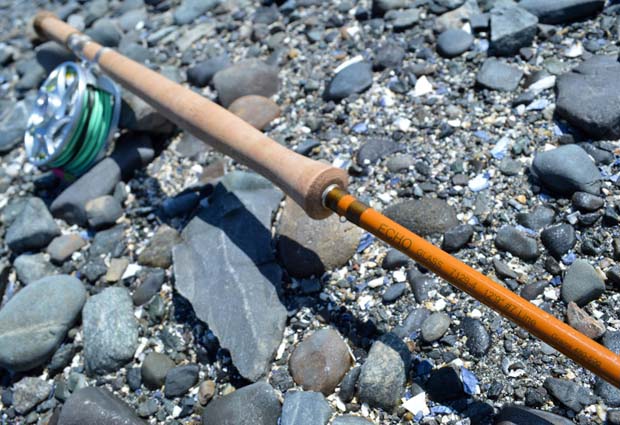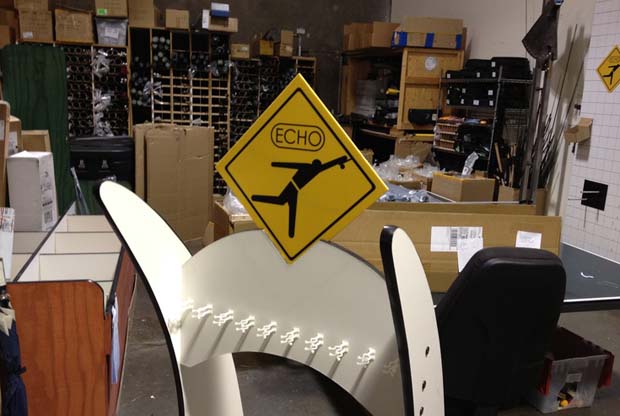Our team here at FLM is a little preoccupied with fly rods; short or long sticks of any religious origin (carbon, glass, Tenkara, etc). We can smell a bs review in two sentences and seldom “read more.” We always look forward to Yellowstone Anglers 5 weight shootout, Robert Morsell’s reviews and sometimes a review will pop out of an internet feed. In particlar, Deneki’s review of Tim Rajeff’s ECHO Glass 7129-4. Tim holds the reigns at Rajeff Sports / Echo Fly Rods. In the fly rod manufacturing biz he has been out front on all things fly rod for about five years. Out staff is all in on his rods. Here is what Deneki had to say.
Crank the fun factor up to 11, ECHO’s new fiberglass spey rods are here
[dropcap]E[/dropcap]ver since we first got wind that ECHO was designing fiberglass two-handers, we’ve been impatiently waiting to get our hands on one. Well, we recently had the pleasure of testing out the ECHO Glass 7129-4, and today we’re going to tell you what we think about it
Background
While today’s ultra fast, high modulus graphite rods have enabled many of us to chuck flies greater distances than ever before, they haven’t come without a cost. They don’t quite have the same ‘feel’ as the rods of old. Many anglers love to feel that deep load of a spey rod, but with most modern graphite rods that’s simply not possible.
Enter, ECHO’s Glass spey rods. By taking advantage of the properties of fiberglass, ECHO has created a series of rods that puts the ‘soul’ back in the spey game. Fiberglass bends more and recovers slower than graphite, allowing for a slower required stroke and more feel throughout the cast. This is not necessarily at the expense of power however, but we’ll cover more on that below.
Design and Features
The model we tested was the 7129-4 (that’s a 4 piece, 12′ 9″, 7 weight). We really like shorter spey rods these days, around 13 feet and under for most situations, rather than the 15 foot and longer sticks of the past. Therefore, we were pretty excited to see the 7 weight came in at 12 feet 9 inches. A traditional action in a modern length is brilliant as far as we’re concerned.
As a 7 weight, it’s certainly at home swinging flies for species like chum salmon, coho, or summer steelhead in most places. However, for larger winter steelhead, or summer steelhead on the Dean, we’d probably recommend bumping up to the 8 weight model.
One of the first things we noticed upon picking up the 7129-4 for the first time was the grips. If you’ve read our reviews before, you know we appreciate a comfortable grip on our spey rods and the grip design on the 7129-4 was actually one of the more comfortable grips we’ve ever cast. There’s a lot of personal preference there of course, but we think most will appreciate the handle design.
As far as aesthetics, we think ECHO hit it out of the park with the Glass series. To compliment the traditional feel of the rod, ECHO kept it classy with components such as an up locking cork reel seat, a more traditional cork handle, and a blank color that mimics that of bamboo, which we think looks pretty darn cool.
 Casting Performance
Casting Performance
Like most people when they think of fiberglass, we expected the 7129-4 to be extremely slow. However, we were a bit surprised when we first picked it up. While its certainly slower than most modern graphite rods, we’d consider it more of a medium action rod than a truly ‘slow action.’
With that said, we weren’t too surprised to find out that slowing down your stroke is the key to getting the most out of the 7129-4. Once we slowed down however, we were pretty impressed at how much line it could handle with a very relaxed stroke. Could we throw it as far as our favorite graphite stick? Not quite, but it was much closer than you might think, and could certainly reach distances used in any practical fishing situation. As would be expected, we found the slower action to turn over heavy sink tips extremely well making for a great skagit tool.
Along with a slower stroke, we also found that a slightly higher stop than normal made for better loops on the forward stroke. We attribute this to a greater tip deflection than most fast action rods (remember, fiberglass bends more than graphite). By stopping a bit higher than normal, we found we were able to really tighten our loops and reach the rod’s full potential.
We also expected the 7129-4 to feel much heavier than it does. While it might not be as light as most high modulus graphite sticks, we didn’t find the difference in weight to be very noticeable. Since a slower, more relaxed stroke is needed anyhow, we don’t think it will cause fatigue any faster than your modern fast action rod might.
Line Match
ECHO’s recommended grain window for the 7129-4 is 480-590 grains. That’s a pretty big window, so we tried everything from a 480 grain Airflo Skagit Switch to a 570 grain Airflo Skagit Compact.
We preferred the 480 grain Skagit Switch , but we tend to like shorter skagit heads (like the Skagit Switch). However, we also thought the 510 grain Skagit Compact was a good match as well and would recommend it for those who prefer a longer skagit head.
We also had a lot of fun slowing the rod way down by casting a 570 grain Skagit Compact. Although we found it to be a little clunky, we were surprised at the rod’s ability to handle it, and wouldn’t rule it out as an option for super heavy flies and sink tips.
We tried each line with sink tips from 10 feet of T-8 to 10 feet of T-14 and found the 7129-4 had no problem turning them over whatsoever.
All in all, we found ECHO’s grain window to be spot on, but feel that the 510 Skagit Compact is likely to fit most casting styles.
Reel Match
We paired the 7129-4 with a Hatch 9 Plus Finatic (10.6 ounces) and found it to balance fairly nicely. If anything, we thought it could take a heavier reel if need be, but feel any reel around the ball park of 10.6 ounces would be a good match.
Summary
This rod is an absolute blast to fish. We like to think of it as ‘bamboo on a budget,’ and would highly recommend it to anyone looking for that classic feel without breaking the bank, which at under $300.00 is pretty reasonable these days.
However, we want to stress that these rods are far from a gimmick to sell more rods. We think they’re an extremely practical tool in many scenarios. Think heavy sink tips, tight quarters, and better leader/tippet protection.
The ECHO Glass spey rods retail for $299.99 and are offered in 6 through 8 weight. Switch models are also available at $279.99 and offered in 3 through 7 weight. For more information, check out ECHO’s website, or visit your local ECHO dealer.
[information]
[/information]


